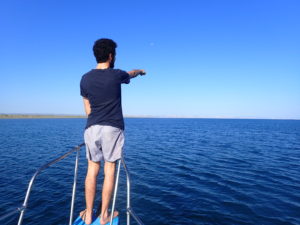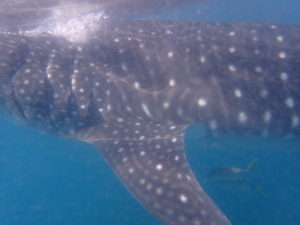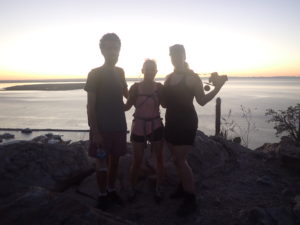Our average day starts with free yoga, where we relax while overlooking the marina below. After a good stretch we walk down the Malecón to the boat launch, where we meet Captain Erick to get the boat ready for our trip. Usually the water in the morning is calm, and it’s an easy boat ride out to the whale shark aggregation areas. One of us always acts as the ‘spotter’ on the boat, standing at the bow and checking the water for the recognizable fins.
Luke the intern acts as a spotter, watching the horizon for shark fins.
On some mornings we find the sharks right away, while on others we look for over an hour without finding anything. We often discuss which sharks we might see, along with enjoying the boat ride. As the currents change, so do the feeding areas for the sharks. As whale sharks are filter-feeders, finding a spot with a high concentration of plankton in the water is essential for survival.
Once a fin is spotted it becomes a rush to get ready, with everyone trying to get their fins, snorkel, and monitoring equipment with them and into the water on time. Captain Erick directs the boat a safe distance (5m) from the shark so that there is no chance of injury to the animal. Once we’re ready, we jump in and start our analysis. One of us will stay on the boat in order to record data including GPS, encounter number, cloud cover, and sea state.
The persons in the water are responsible for taking a photo-identification shot, checking the sex of the animal, as well as noting any injuries or other comments. Some of the sharks we see are easily identifiable as ones we have seen before by their spot patterns or specific injuries.
A photo ID shot used to identify the whale shark.
Once the data has been taken, we usually get back into the boat and move on to the next shark. This allows other boats to come and interact with the whale shark, as well as giving the shark a break from human interactions. It’s important not to disturb feeding sharks for too long, as they are relying on the plankton to sustain their energy.
Usually our trips contain sightings of bottlenose dolphins, and occasionally mobula rays or turtles. It’s always exciting to see other ocean life while on our monitoring trips.
After 3 hours of monitoring, we head back into town for the afternoon. Often we walk back to our apartment, where we process the data from the morning boat trip. This includes imputing all the information we collect into a program, and comparing photos to identify each whale shark. Sometimes there is a match in the database, or it might be a shark we haven’t seen before, so we instead count it as a new shark.
Once we’ve finished our work for the afternoon, we either cook at home and play cards, or check out the local cuisine and head downtown for beach volleyball or a walk on the Malecón.
Enjoying the local hiking trails.
For more information about how you can get involved, check out our internship page: http://www.whalesharkdiaries.com/internship-program/
Blog Post Created By: Danielle Duncan (California U.S.A.), Luke Nolan-Legudi (Melbourne, Australia), Sierra Rae (British Columbia, Canada), Whale Shark Diaries Interns.
Like and Share Our Facebook Page and Follow Us on Instagram
Facebook Page [scroll down for Instagram]



